Menus
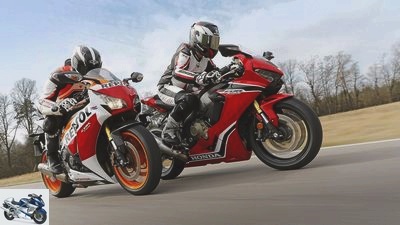
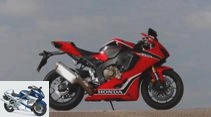

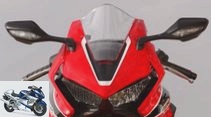
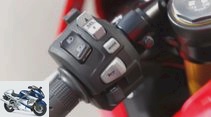
26th photos
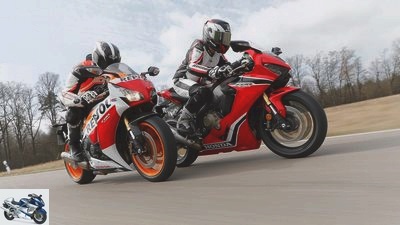
1/26
Honda Fireblade (2016) and Honda Fireblade (2017) in comparison test
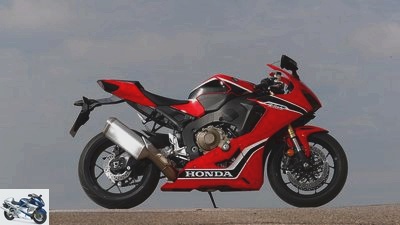
2/26
Their visual appearance matches that on the street: sharper, more delicate, more jagged
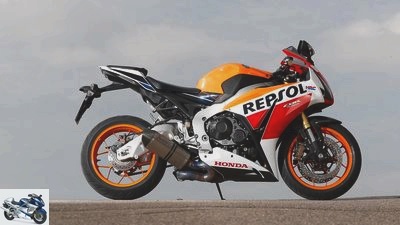
3/26
Still a very good motorcycle, confident, easy to control, good-natured
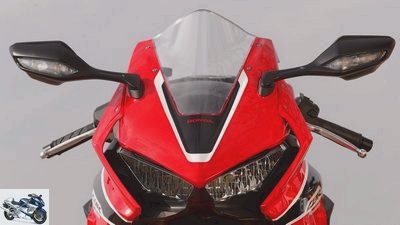
4/26
Honda Fireblade (2017): Sharply cut LED headlights, slimmer fairing that offers little wind protection
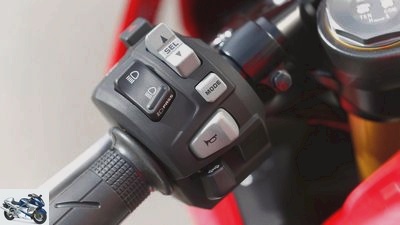
5/26
Honda Fireblade (2017): The display is easy and intuitive to operate, the horn and indicator buttons have swapped positions
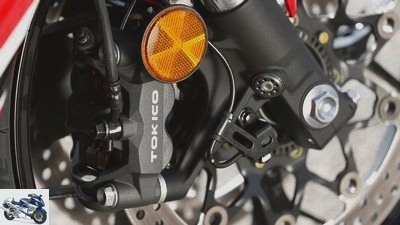
6/26
Honda Fireblade (2017): New brake calipers and discs, on the country road with impeccable effect, and now also cornering ABS
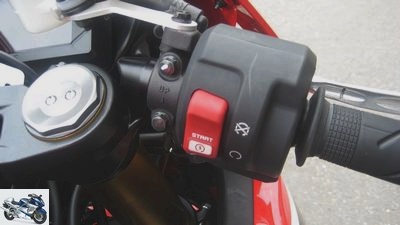
Andreas Bildl
7/26
Honda Fireblade (2017): Something is missing? I agree. Instead of throttle cables, the right handlebars now have an electronic throttle grip
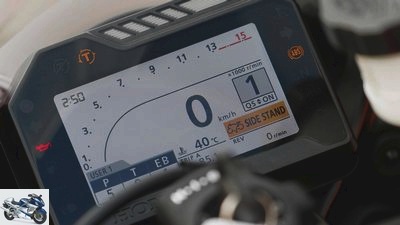
8/26
Honda Fireblade (2017): The TFT (Thin Film Transistor) display is not overloaded, informative and easy to read

9/26
Honda Fireblade (2017): Thanks to optimized casting technology, the rear frame saves 600 grams of weight with the same rigidity
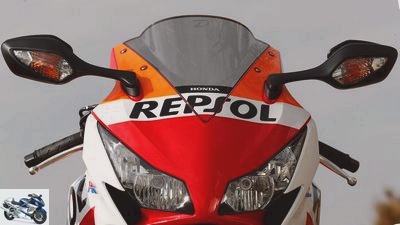
10/26
Honda Fireblade (2016): Comparatively large headlights and a wide upper part of the fairing with a good windbreak
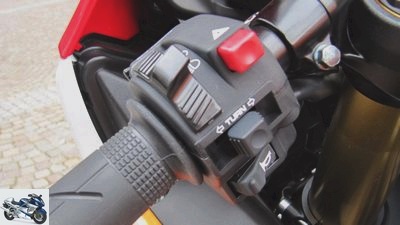
Andreas Bildl
11/26
Honda Fireblade (2016): Greetings from the past: simple switch unit for the essentials, cleanly locking switches
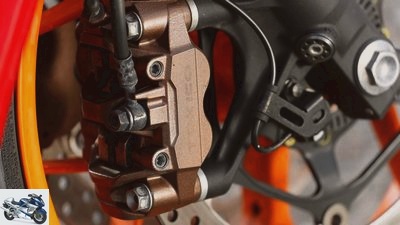
12/26
Honda Fireblade (2016): Still a bank in terms of braking performance, but the pressure point and controllability could be better
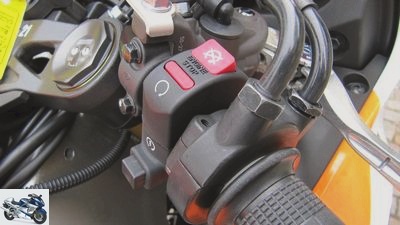
Andreas Bildl
13/26
Honda Fireblade (2016): While the electronic throttle was already used in the World Cup, the series still had Bowden cables

14/26
Honda Fireblade (2016): In terms of readability, the LC display is only the second winner, and both do without an outside temperature display
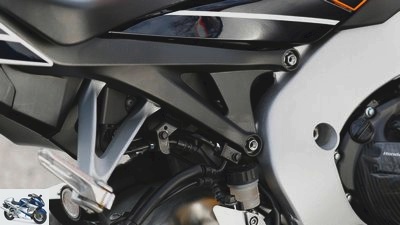
15/26
Honda Fireblade (2016): The frame construction is so successful that it is also suitable as a basis for the current generation

16/26
Symbolic for the competition, the new one pushes past its predecessor.

17/26
Honda Fireblade (2016): It lies full, confidence-inspiring, stable, the SC59, but the new one is much more agile.

18/26
Honda Fireblade (2016) and Honda Fireblade (2017) in comparison test
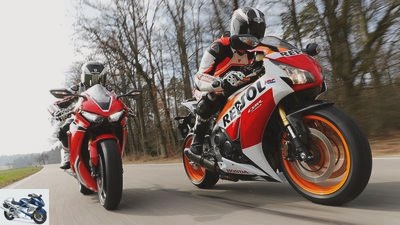
19/26
Honda Fireblade (2016) and Honda Fireblade (2017) in comparison test

markus-jahn.com
20/26
Honda Fireblade (2016) and Honda Fireblade (2017) in comparison test

21/26
Honda Fireblade (2016) and Honda Fireblade (2017) in comparison test
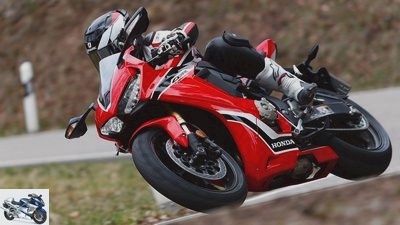
22/26
Honda Fireblade (2016) and Honda Fireblade (2017) in comparison test
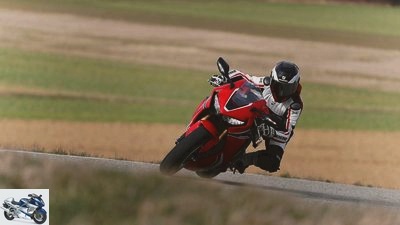
23/26
Honda Fireblade (2016) and Honda Fireblade (2017) in comparison test
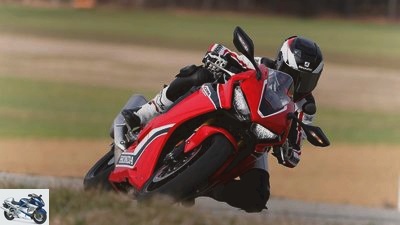
24/26
Honda Fireblade (2016) and Honda Fireblade (2017) in comparison test
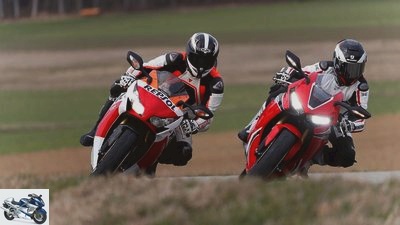
25/26
Honda Fireblade (2016) and Honda Fireblade (2017) in comparison test
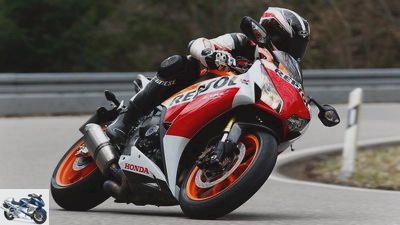
26/26
Honda Fireblade (2016) and Honda Fireblade (2017) in comparison test
Honda Fireblade (2016) and Honda Fireblade (2017) in comparison test
Old against new
Hurry with a while was the motto for the renovation of the Fireblade. The result was not a completely new design, but a revised version of the previous Honda Fireblade. With more power, less weight and modern electronics. But new is also better in this case?
Honda has eight years laying the new keel F.ireblade time left. During this time, the competition has upgraded a lot and added one briquette after the other. It seemed a little surprising that Honda of all people, never at a loss for innovative solutions, first took a quiet look at what its competitors are doing in the technically highly developed segment of superbikes before they – also put under pressure by Euro 4 – the New edition of the Fireblade sent into the race.
Buy complete article
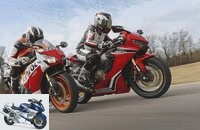
Honda Fireblade (2016) and Honda Fireblade (2017) in comparison test
Old against new
Video of the new Honda Fireblade (model year 2017)
The ergonomics
Although the base is the same in notch and handlebar position, the SC77 pilot finds the more pleasant place. Because thanks to the narrower tank flanks and the tapered seat padding, the new one offers a much tighter knee joint, which makes it even more compact and makes contact with the machine even more intense. On the way to the test lap on the autobahn, however, it also becomes apparent that its narrowly cut fairing offers noticeably less wind protection, but more noise than the wide fairing front of the predecessor. And you can’t expect much more consideration in the mirrors. The bottom line, however, is that she has a sharp nose ahead in this chapter.
The motor
He determines the character of the machine. In its basic features it remained unchanged. Same bore-to-stroke ratio, the same gears, practically identical housing. And yet there was fine-tuning in many areas. The slipper clutch has been redesigned and the magnesium alloy housing cover saves weight. Higher compression, modified valve timing, new, lighter pistons, plus two throttle valves enlarged to 48 millimeters give the four-cylinder a completely new character. You can feel it as you roll out of town. When starting up, the detached SC59 comes out of the starting blocks with more pressure, while the SC77 rolls up smoothly, but a little more restrained. When the clutch is engaged, it increases the engine speed a little to support starting – up to 2200 rpm after a cold start. On the first few kilometers, which are completed with a maximum of 4000 rpm, the predecessor flexes its muscles a little more vigorously and looks more powerful, the SC77 with its softer clutch, smooth acceleration and smoother engine run in the lower half of the speed.
But as soon as the shackles of the city limits are stripped, the picture begins to change, although the test bench shows almost the same performance curves for the two, with recognizable advantages for the old in the lower speed range. When you first step into the apex of tight bends, it appears consequently more energetic. But she cannot break away from her successor. This conceals its lower performance in the lower area with a slightly shorter overall gear ratio (43 teeth instead of 42 teeth at the rear). A look at the traction diagrams shows that there is virtually a tie in the lower gears. The new one goes straight to the gas, more spontaneous, lively. But also harder with more play in the drive train. Nevertheless: In connection with the weight of a whopping 16 kilograms lower, it gives the impression of being much livelier. The more pronounced torque dent in the middle area is more noticeable than on the predecessor. But the resulting impression of supposed weakness is deceptive. A look at the torque values in the lower aisles speaks volumes. Above all from 7000 rpm, the new one pulls away irresistibly, albeit accompanied by increasing vibrations. In its current version, the Fireblade engine delights with juicy revving, and in its playful way up the speed ladder, it is almost reminiscent of a 600. An impression that also fits the compactness of the Blade mentioned at the beginning. The significant increase in performance from 11,000 rpm on the public highway is more of an academic nature. The new one can hardly capitalize on it, because already in second gear you are beyond good and evil. The light-footed, spirited revving, the pithy sound when the exhaust flap opens at 6000 rpm, but all of this condenses into greater entertainment value. Which is not even bought with increased consumption. The informative TFT display showed a total consumption of 5.4 liters on the almost 120-kilometer consumption lap. 5.6 liters gurgled into the tank. The display can thus go through as quite accurate. On the leisurely lap of the country road, the new one sipped 4.6 liters per 100 kilometers, even a tenth more cautiously than the already modest 2016 Blade with 4.7 liters.
Even on the test lap that was quickly completed, the consumption rating of 5.3 to 5.6 liters is just about the new one. Which at least compensates a bit for its 1.7 liter smaller tank.
The landing gear
Always the great strength of the Fireblade. Also and especially the SC59, which in its eight-year construction period scored particularly well in the comparison tests with its good-natured, stable chassis. So it is no coincidence that the Honda technicians only made moderate changes to the frame and swing arm update. Basically, they only affect the wall thickness in isolated cases and thus a slightly changed stiffness balance. Which also saves around 300 grams on the chassis. Steering head angle, caster and installation position of the motor together with the pivot point, however: same procedure as last year. So there shouldn’t be any big surprises waiting, right? Oh but!
In terms of feedback, coordination of the suspension elements and stability in an inclined position – both in fast and slow corners – the last generation of blades was good at music. As expected, she also shines in these disciplines on the ride together. Has a confidence-inspiring effect in every situation, calmly gives in. And this is exactly where the new one raises the bar. In a direct comparison, the gain in handiness becomes apparent. Where the old Blade wanted to be steered into the curve, the new one literally leads its driver into it. She plunges almost greedily towards the apex of the curve, playfully changes the incline and literally sucks on the tight line. The difference becomes particularly clear at higher speeds. But also tight and twisted curve combinations are a pleasure, in no time the new one has threaded its way through. Your newly tuned fork irons over asphalt wrinkles a little more sensitively than its counterpart in its predecessor. Their suspension strut absorbs hard edges a little more carefully.
The significant handling plus is therefore not primarily due to radical chassis interventions, but also to the strong slimming cure, which is ultimately accompanied by an even better concentration of the masses around the center of gravity. The titanium silencer has become 2.8 kilograms lighter, around two kilograms have been saved on the engine, and the rear frame contributes 600 grams in weight savings. When wagging bends, the new one casually shows the rear light. Likewise when braking. The stoppers, equipped with new Tokico pliers, lack the last bit of crispness in terms of pressure point. But the brakes, which were criticized for their somewhat doughy effect in the driving report on the racetrack, grip much more energetically and more transparently than the brake cocktail of the predecessor at country road speed.
And otherwise?
In terms of electronics, the Fireblade lagged miles behind the competition until last season. Now it is absolutely up to date. Ride-by-wire has become indispensable anyway. A five-axis Bosch IMU (Inertial Measurement Unit) controls the combined traction / wheelie control and feeds the ABS, which is suitable for sloping, and cannot be switched off with data. The motor brake can be adjusted in three stages. That works inconspicuously and well. In addition to lap times and lean angles, the TFT display offers three display forms, Street, Track and Mechanic, and, like the entire electronics, can be operated intuitively from the handlebars. In addition to three preset riding modes, the pilot can also compose his own combination of power output, traction control and engine braking in two modes. The SC59 could only dream of that, as well as of the now optionally available, very fine automatic switch with blipper function (699 euros). Or from the LED headlights, which shine more precisely but also brighter. Which actually sums up the relationship between the two.
MOTORCYCLE conclusion
The hoped-for quantum leap did not materialize. Even if the engine looks livelier and livelier and has a little more power at the top, the revision has not brought any sweeping improvements here. The new one sets itself apart from the old one mainly through the skilfully redesigned chassis and the amazing lightness that has been gained. In the thicket of bends, the new one seems detoxified, more playful, fresher. Combined with the slimmer appearance and the lively rotating unit, the Fireblade has clearly trimmed its character towards sportiness. And at the same time keep their gentle, easy-to-control nature. All in all, it makes it the better, overall best Fireblade, even without spectacular top performance.
Related articles
-
Honda Fireblade SP and Kawasaki ZX-10R in the test
Jahn 44 photos Jahn 1/44 When it comes to price-performance ratio, the Kawasaki ZX-10R can convince more. Jahn 2/44 Bye-bye screwed adjustment rings and…
-
2017 travel enduros from BMW, Ducati, Honda, KTM and Triumph in a comparison test
Rivas 50 photos Rivas 1/50 2017 travel enduro in comparison test. Rivas 2/50 BMW, Ducati, Honda, KTM and Triumph in the battle for control of the travel…
-
Honda Fireblade vs. Suzuki GSX-R 1000 in comparison test
Maccabelli The last four-cylinder without control electronics Test: Honda Fireblade against Suzuki GSX-R 1000 Content of They are the last current…
-
Honda Crossrunner and Suzuki V-Strom 1000 in comparison test
fact 30th photos markus-jahn.com 1/30 Honda Crossrunner and Suzuki V-Strom 1000 in comparison test. markus-jahn.com 2/30 Honda Crossrunner and Suzuki…
-
Comparison test Ducati 996 S, Honda CBR 900 RR, Triumph Daytona 955i
PhotoGargolov Comparison test Ducati 996 S, Honda CBR 900 RR, Triumph Daytona 955i Strategy games Win with four? Or would you rather be brisk with three?…
-
Jahn comparison test of supersports: Ducati 998, Honda Fireblade, Kawasaki ZX-9R, Suzuki GSX-R 1000, Triumph Daytona 955i Centennial The K-Question Five …
-
Comparative test of athletes: BMW S 1000 RR against Honda Fireblade
13 Bilder Kunstle 1/13 The on-board tool kit of the BMW almost ties in with old traditions. With the help of the nine-piece set you can …
-
Comparison test between the Honda XR 125 L and the MZ 125 SX
Jahn comparison test Honda XR 125 L against MZ 125 SX New times Cheap Honda against expensive MZ, ancient engine from Japan against high-tech four-valve …
-
Performance test Honda Fireblade SP
Clippers 30th photos Jahn 1/30 The new Honda CBR 1000 RR Fireblade in the horsepower performance test. Jahn 2/30 The new Honda CBR 1000 RR Fireblade in…
-
Comparison test BMW K 1200 RS against Honda CBR 1100 XX
Comparison test BMW K 1200 RS against Honda CBR 1100 XX Crown jewels K 1200 RS and CBR 1100 XX are the image carriers of BMW and Honda. You don’t just…